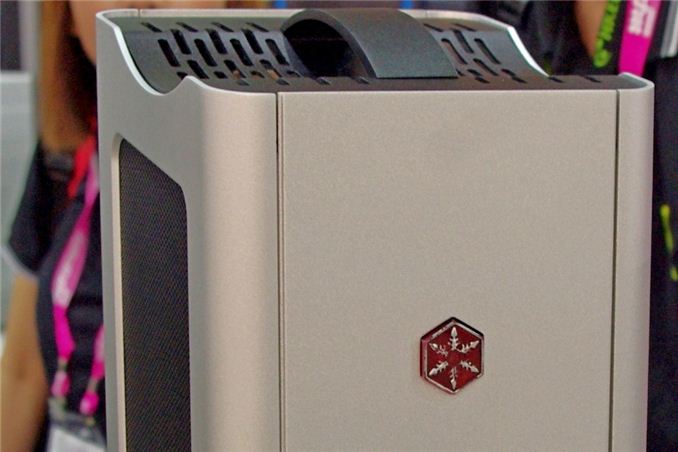Computex 2013: Thunderbolt Graphics from SilverStone
by Ian Cutress on June 6, 2013 9:34 PM EST- Posted in
- Trade Shows
- SilverStone
- Thunderbolt
- Computex 2013

Visiting the SilverStone booth was rather interesting. In a similar ilk to MSI’s GUS which used Thunderbolt to transmit data over PCIe, Silverstone are developing their own at-home device capable of dual-width GPUs up to 450W.
This is still in the development cycle – the main issue with MSI’s device (and I’d assume Silverstone as well) is how to deal with hot-plugging during the middle of intense GPU workloads. Aside from frame buffer management, at the point in time when the device is detatched there is no longer access to any data on the card – the PC or laptop then has to transfer what it knows to the frame buffer on the IGP and recalculate. Sounds easy-ish, but not a trivial task by any means.
Silverstone told me there is no release date as such as they are still in the alpha phase of development, but they are aiming for the $200-250 price point without a GPU.


















34 Comments
View All Comments
Aikouka - Thursday, June 6, 2013 - link
Don't USB-based graphics adapters already exist? Wouldn't they have the same issues when you unplugged them?Gigaplex - Thursday, June 6, 2013 - link
They're extremely low performance CPU based adapters. When unplugging them, you lose the display connection, not the computational resources.DanNeely - Thursday, June 6, 2013 - link
USB2 only has enough theoretical bandwidth to do 800x600x16x60hz before needing compression. In practice even that would need some compression.On paper USB3 has enough bandwidth for 1080p with room to spare; you'd still probably run into problems trying to game in it though. USB is designed to be cheap to implement and lacks the QoS guarantees needed for consistent low latency performance.
jameskatt - Friday, June 7, 2013 - link
I run my USB 2.0 display adapter at 1920x1200x32x60Hz for video conferencing. Obviously, USB2 has enough bandwidth to do this.Death666Angel - Friday, June 7, 2013 - link
It uses compression to do that.DanNeely - Friday, June 7, 2013 - link
Video conferencing is **massively** compressed because most peoples upstream pipe has less bandwidth than USB1's 12 megabits.winterspan - Saturday, June 8, 2013 - link
this is not for routing video signals to a monitor.. an external GPU needs a huge amount of bandwidth back to the CPU, hence the PCIe x8/x16 connectionsHisDivineOrder - Thursday, June 6, 2013 - link
Finally, Thunderbolt will have a point for a majority of laptops.Dentons - Thursday, June 6, 2013 - link
Maybe.$250 will buy the core of an adequate desktop PC. Given that the GPU has to be purchased in either case, this will only offer a minimal cost reduction over buying a desktop machine.
If this box were $49, then it might be a viable option. Even so, it seems to be a solution looking for a problem.
DanNeely - Friday, June 7, 2013 - link
A decent PSU alone will run close to $50; add a decent quality enclosure and $100 seems a reasonable price point.